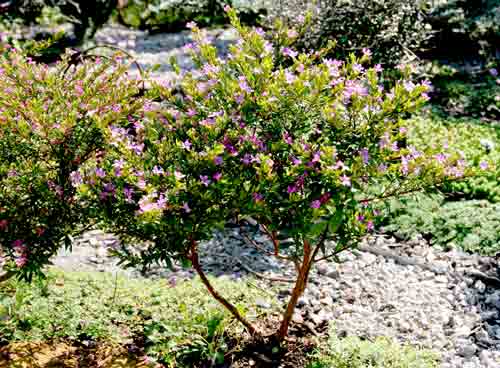
The fact that Mark’s miniature nursery resides in northern Ohio should not dissuade you from the accuracy of the information contained herein. The plants have withstood Ohio’s hot, humid summers, with conditions sometimes not too different from those in Florida. Of course, the plants go into the greenhouse for the winter. So use the ideas presented here and look in your area for local sources of these plants, or check the Internet for online retail mail-order sources. Those of you in the southwestern US, look for plants that like dry, sunny conditions while those in the southeast should favor plants that tolerate a hot, moist environment.
Tiny Kyoto snowrose (Serissa foetida ‘Kyoto’) is one of the tropical plants I have in my railroad garden. It’s worth the effort of potting it up every fall and moving it indoors, where it does very well in moderate light and cooler temperatures. There are several varieties of snowrose/serissas (Cherry Blossom, Double White, Pink Mountain, Yatsubusa), Kyoto having the smallest leaves at 1/4″, and all enjoying sun/part sun, normal/wet, and organic-loamy soil. Kyoto and Yatsubusa grow to 1′ tall, the others to 2′, making lovely little trees with minimal trimming.
Dwarf snowbush/breynia, (Breynia disticha ‘Rosea Picta Nana’) is a colorful little tree year-round. Its white, pink, and green marbled leaves, normally 1/2″ across, grow to only 1/4″ when rootbound (potted) or stressed. Keep its soil on the lean side in shade/part shade to help it “self-bonsai” to a dramatic, colorful specimen only 1′ tall by 6″ wide when mature. This plant tolerates typical northern-winter indoor environments admirably.
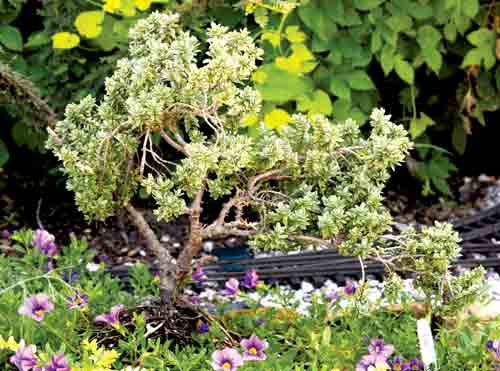
Mini-purple elfin herb (Cuphea hyssopifolia ‘Mini-leaved Purple’) is just the ticket if you’re looking for a colorful, flowering, tiny-leafed shrub that easily trims into a fantastic little tree, growing no more than a foot tall. Besides purple, elfin herb also comes in pink, red, and white. They are very adaptable, growing in full shade to part sun and thriving on normal-to-wet organic soil.
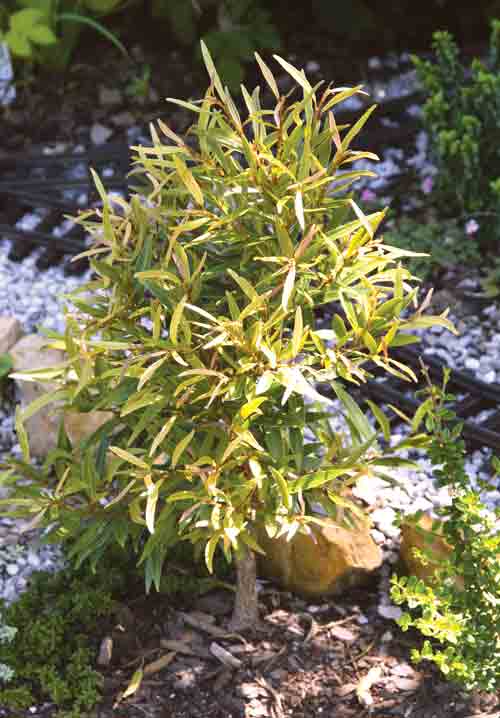
Ficus trees are favorites in homes and businesses because of their ease of culture. Now you can get two really small ones that stay under 18″ tall for your railroad garden. A super small ficus (Ficus sp.-Mark doesn’t have a cultivar name for this one yet) will grow in sun to part sun, and Too Little ficus (Ficus x ‘Too Little’) grows best in part shade to part sun. Another new offering is willow-leaf ficus (Ficus subulata or F. salicifolia). This beauty has elongated leaves that develop a bronze tint in full sun. It will eventually grow to 6′ tall but can be trimmed and trained into a good-looking miniature tree. All ficus trees prefer moist organic soil. They winter indoors easily as house plants.
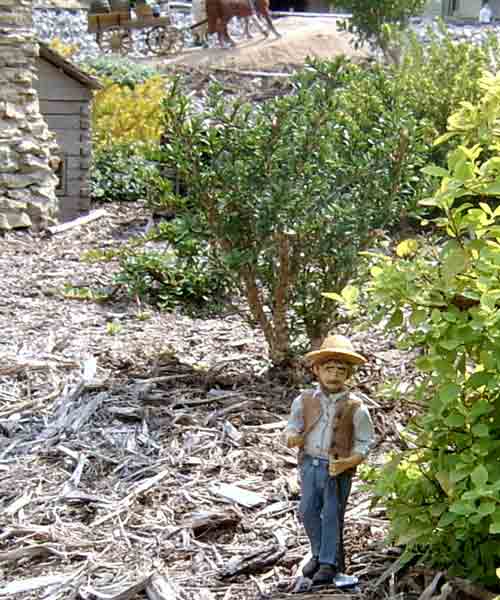
Hebes (Hebe spp.) might be considered southern boxwoods. One particularly nice one is H. topiaria, with its bonus of white flower clusters in summer. It will grow 10″ tall and thrives in sun/part sun and sandy-loam.
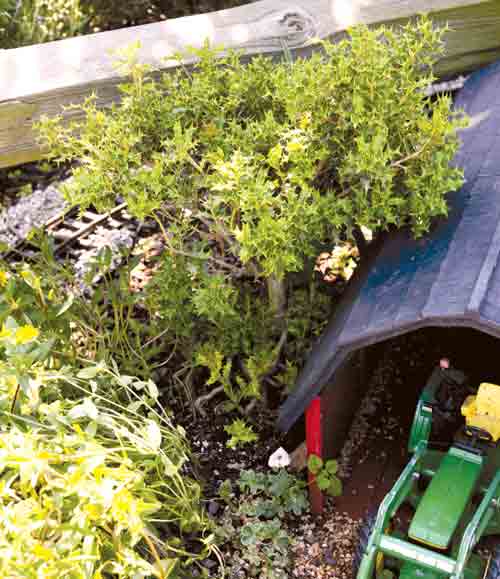
English miniature holly (Ilex dimorphotheca ‘Okinowa’) makes a very architectural tree, with its stiff form and 1/2″ long, spiny, dark-green leaves. It’s slow growing, taking 20 years to reach 3′ high. Hollies like moist, acidic, organic soil and grow best in part shade, but will tolerate full sun.
Mini yellow privet or box honeysuckle (Lonicera nitida ‘Baggesen’s Gold’) will add a spark of golden color to your railroad scene. With tiny 3/8″ leaves crowding together on closely spaced branches, this beauty will make a great hedge to complement your hotel, town hall, or executive mansion. If left to grow taller and trimmed to show individual branches, it will transform into a colorful tree. Just make sure it gets sun to part sun and loose, sandy loam to grow in.
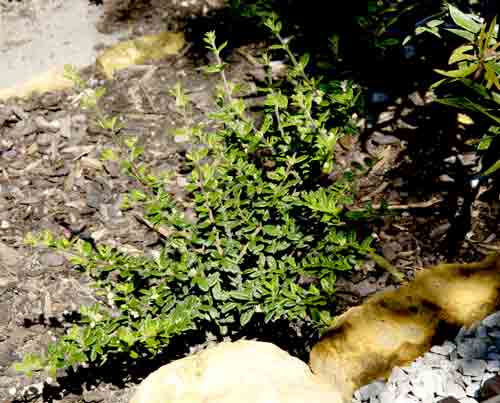
Moujean tea (Nashia inaguensis) is an herb with a hankering to be made into a miniature tree. Besides petite, glossy leaves, it sports tiny cream-colored flowers followed by mini, 1/8″ orange fruits. Unchecked, it can grow 2′ tall but is easily trimmed into a tree form. Plant it in full sun in normal, organically enriched soil.
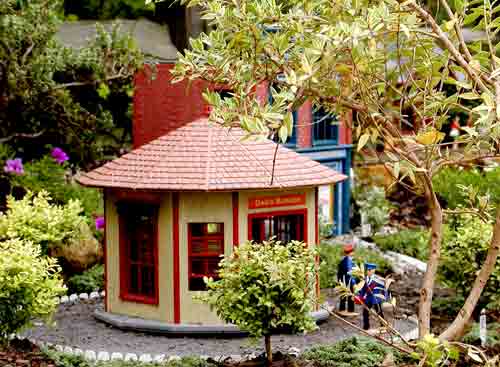
Mini myrtle (Myrtus communis var. tarentenia ‘Microphylla Variegata’) is prized by topiary and bonsai enthusiasts for its beauty and adaptability to tree forms. Its weeping habit, white-striped leaves, and white flowers give it a distinctive look. Although it can grow to three feet tall, it is easily trained and trimmed and could become a prize specimen tree in your landscape. Give it full sun and organic, loamy soil. Those of you in the northern tier of states don’t have to miss out on the joy of growing this beauty-it converts well into a houseplant for the winter.
Herb Cottage rosemary (Rosmarinus officinalis ‘Herb Cottage’) is one of a number of upright-growing rosemarys that can be trained into impressive miniature trees. Herb Cottage has a nice shape, with branches jammed with leaves. In the south this specimen will take the spotlight with fluorescent-blue flowers in the spring. Other rosemarys that would lend themselves well to making little trees include golden rain (R. officinalis ‘Joyce DeBaggio’) and Mrs. Reed’s Dark Blue (R. officinalis ‘Mrs. Reed’s Dark Blue’). Rosemarys are Mediterranean plants. They thrive in hot, dry climates, growing in full sun and loose, well-drained soil. They do well in the southwest but in the humid southeast they need room to breathe and dry off. Water only when drought stressed. They can be easily potted and brought indoors in the north. Place them in your sunniest window in a cool room and water only when the soil is dried out.

Confetti bush (Coleonema pulchrum) and skeleton tree (Corokia cotoneaster) are two plants that could not be more different. Confetti bush has light green, feathery foliage while skeleton tree has twisted, stiff, and spiky-looking stems with tiny, dark-green/black leaves that look more like branch ends. Minute yellow flowers appear in winter on skeleton tree, while white-maturing-to-pink flowers adorn confetti bush. The former can grow to 3′ tall and the latter seldom gets bigger than 18″ x 18″. Confetti bush looks great trained as a tree, its cherry-tree-like bark adding to its distinctive appearance.
Small flowering plants such as scented geraniums (Pelargonium spp.) and fuschias (Fuschia spp.) can also be trained into colorful trees. Jade trees (Crassula spp.), which are common house plants, and tea trees (Leptospermum spp.) also make great little trees in scale with our railroad gardens.
The warm regions of the world have produced a wide variety of small plants, many making good raw material for miniature trees. A little research and creativity are all you need to populate your miniature landscape with an assortment of new trees.
Sources
Mulberry Creek Herb Farm and Miniatures
www.mulberrycreek.com
Arrowhead Alpines
www.arrowheadalpines.com














curious to know if many of these are tolerant of Arizona’s summer heat, I live in Peoria ( NW side of Phoenix and in zone 9, but some that they say are tolerant of zone 9 have not done well or died even with shading them during the summer